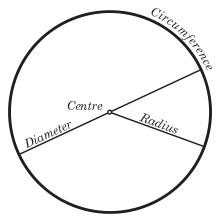- Diameter
-
For the notion of diameter in graph theory, see Distance (graph theory). For the computer network protocol, see Diameter (protocol).
In geometry, a diameter of a circle is any straight line segment that passes through the center of the circle and whose endpoints are on the circle. The diameters are the longest chords of the circle. The word "diameter" derives from Greek διάμετρος (diametros), "diagonal of a circle", from δια- (dia-), "across, through" + μέτρον (metron), "a measure"[1]).
In more modern usage, the length of a diameter is also called the diameter. In this sense one speaks of the diameter rather than a diameter, because all diameters of a circle have the same length, this being twice the radius.
For a convex shape in the plane, the diameter is defined to be the largest distance that can be formed between two opposite parallel lines tangent to its boundary, and the width is defined to be the smallest such distance. For a curve of constant width such as the Reuleaux triangle, the width and diameter are the same because all such pairs of parallel tangent lines have the same distance. See also Tangent lines to circles.
Contents
Generalizations
The four definitions given above are special cases of a more general definition. The diameter of a subset of a metric space is the least upper bound of the distances between pairs of points in the subset. So, if A is the subset, the diameter is
- sup { d(x, y) | x, y ∈ A } .
Some authors prefer to treat the empty set (
 ) as a special case.[2]
) as a special case.[2]In differential geometry, the diameter is an important global Riemannian invariant. In plane and coordinate geometry, a diameter of a conic section is any chord which passes through the conic's centre; such diameters are not necessarily of uniform length, except in the case of the circle, which has eccentricity e = 0.
In medical parlance the diameter of a lesion is the longest line segment whose endpoints are within the lesion.
Diameter symbol
The symbol or variable for diameter, ⌀, is similar in size and design to ø, the Latin small letter o with stroke. Unicode provides character number 8960 (hexadecimal 2300) for the symbol, which can be encoded in HTML webpages as ⌀ or ⌀. The character can be obtained in Microsoft Windows by holding the [Alt] key down while entering 8 9 6 0 on the numeric keypad. On an Apple Macintosh, the diameter symbol can be entered via the character palette (this is opened by pressing ⌥⌘T in most applications), where it can be found in the Technical Symbols category.
The character often will not display correctly, however, since most fonts do not include it. In most situations the letter ø is acceptable, which is unicode 0248 (hexadecimal 00F8). It can be obtained in UNIX-like operating systems using a Compose key by pressing, in sequence, Compose / o and on a Macintosh by pressing ⌥O (in both cases, that is the letter o, not the number 0).
In LaTeX the symbol is achieved with the command \diameter which is part of the wasysym package.
The diameter symbol ⌀ is distinct from the empty set symbol ∅, from an uppercase phi Φ, and the Nordic vowel Ø.
See also
- Graph or network diameter
- Angular diameter
- Hydraulic diameter
- Caliper, micrometer, tools for measuring diameters
- Eratosthenes, who calculated the diameter of the Earth around 240 BC.
- Jung's theorem, an inequality relating the diameter to the radius of the smallest enclosing ball
- Sauter mean diameter
- Inside diameter
Notes
Categories:- Elementary geometry
- Length
- Greek loanwords
Wikimedia Foundation. 2010.


